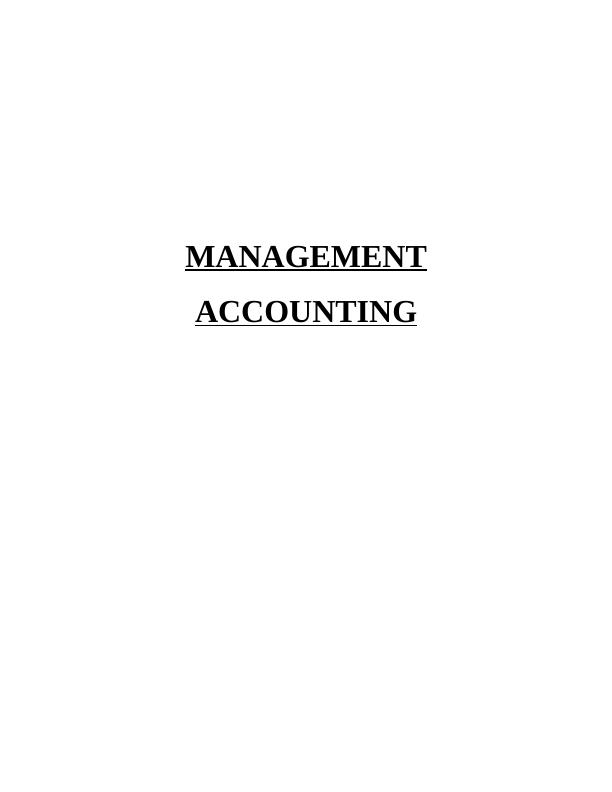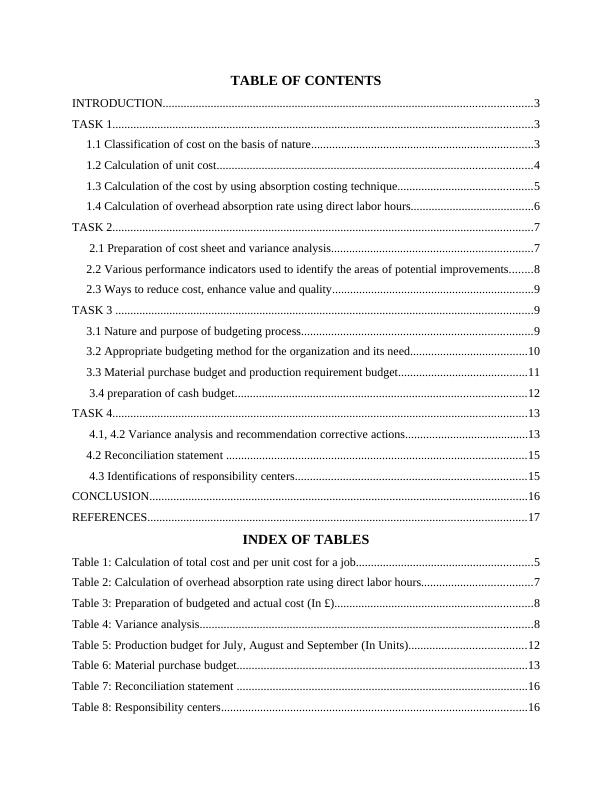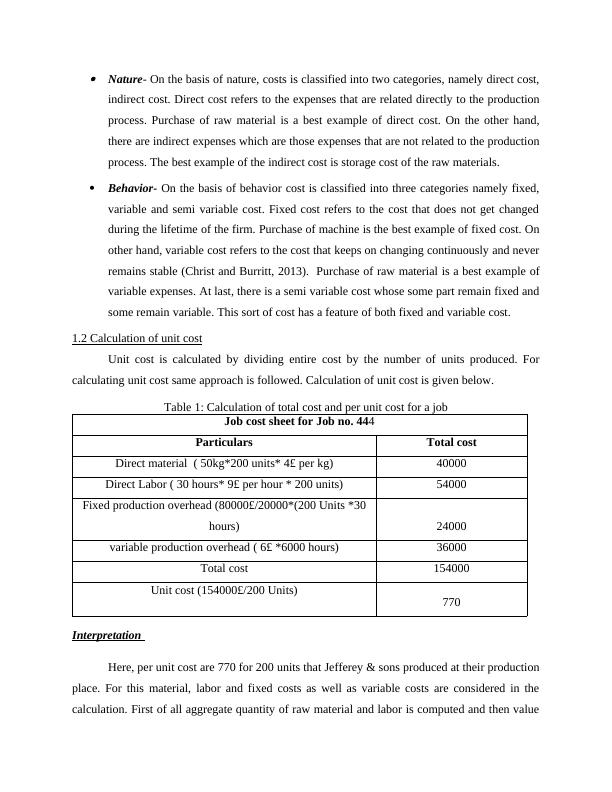MANAGEMENT ACCOUNTING TABLE OF CONTENTS INTRODUCTION 3
18 Pages5408 Words408 Views
Added on 2020-01-28
About This Document
MANAGEMENT ACCOUNTING TABLE OF CONTENTS INTRODUCTION 3 TASK 13 1.1 Classification of cost on the basis of nature 3 1.2 Calculation of unit cost 4 1.3 Calculation of the cost by using variable costing technique5 1.4 Calculation of overhead absorption rate using direct labor hours6 TASK 27 2.1 Preparation of cost sheet and variance analysis 7 2.2 Various performance indicators used to identify the areas of potential improvements 8 2.3 Ways to reduce cost, enhance value and quality 9 TASK 39 3.1 Nature and purpose of budgeting process 9
MANAGEMENT ACCOUNTING TABLE OF CONTENTS INTRODUCTION 3
Added on 2020-01-28
ShareRelated Documents
MANAGEMENT
ACCOUNTING
ACCOUNTING

TABLE OF CONTENTS
INTRODUCTION...........................................................................................................................3
TASK 1............................................................................................................................................3
1.1 Classification of cost on the basis of nature..........................................................................3
1.2 Calculation of unit cost.........................................................................................................4
1.3 Calculation of the cost by using absorption costing technique.............................................5
1.4 Calculation of overhead absorption rate using direct labor hours.........................................6
TASK 2............................................................................................................................................7
2.1 Preparation of cost sheet and variance analysis...................................................................7
2.2 Various performance indicators used to identify the areas of potential improvements........8
2.3 Ways to reduce cost, enhance value and quality...................................................................9
TASK 3 ...........................................................................................................................................9
3.1 Nature and purpose of budgeting process.............................................................................9
3.2 Appropriate budgeting method for the organization and its need.......................................10
3.3 Material purchase budget and production requirement budget...........................................11
3.4 preparation of cash budget.................................................................................................12
TASK 4..........................................................................................................................................13
4.1, 4.2 Variance analysis and recommendation corrective actions.........................................13
4.2 Reconciliation statement ....................................................................................................15
4.3 Identifications of responsibility centers.............................................................................15
CONCLUSION..............................................................................................................................16
REFERENCES..............................................................................................................................17
INDEX OF TABLES
Table 1: Calculation of total cost and per unit cost for a job...........................................................5
Table 2: Calculation of overhead absorption rate using direct labor hours.....................................7
Table 3: Preparation of budgeted and actual cost (In £)..................................................................8
Table 4: Variance analysis...............................................................................................................8
Table 5: Production budget for July, August and September (In Units).......................................12
Table 6: Material purchase budget.................................................................................................13
Table 7: Reconciliation statement .................................................................................................16
Table 8: Responsibility centers......................................................................................................16
INTRODUCTION...........................................................................................................................3
TASK 1............................................................................................................................................3
1.1 Classification of cost on the basis of nature..........................................................................3
1.2 Calculation of unit cost.........................................................................................................4
1.3 Calculation of the cost by using absorption costing technique.............................................5
1.4 Calculation of overhead absorption rate using direct labor hours.........................................6
TASK 2............................................................................................................................................7
2.1 Preparation of cost sheet and variance analysis...................................................................7
2.2 Various performance indicators used to identify the areas of potential improvements........8
2.3 Ways to reduce cost, enhance value and quality...................................................................9
TASK 3 ...........................................................................................................................................9
3.1 Nature and purpose of budgeting process.............................................................................9
3.2 Appropriate budgeting method for the organization and its need.......................................10
3.3 Material purchase budget and production requirement budget...........................................11
3.4 preparation of cash budget.................................................................................................12
TASK 4..........................................................................................................................................13
4.1, 4.2 Variance analysis and recommendation corrective actions.........................................13
4.2 Reconciliation statement ....................................................................................................15
4.3 Identifications of responsibility centers.............................................................................15
CONCLUSION..............................................................................................................................16
REFERENCES..............................................................................................................................17
INDEX OF TABLES
Table 1: Calculation of total cost and per unit cost for a job...........................................................5
Table 2: Calculation of overhead absorption rate using direct labor hours.....................................7
Table 3: Preparation of budgeted and actual cost (In £)..................................................................8
Table 4: Variance analysis...............................................................................................................8
Table 5: Production budget for July, August and September (In Units).......................................12
Table 6: Material purchase budget.................................................................................................13
Table 7: Reconciliation statement .................................................................................................16
Table 8: Responsibility centers......................................................................................................16

INTRODUCTION
Currently, firms are competing with each other on the basis of price irrespective of the
sectors in which they operate. This makes it inevitable for the firms to reduce their cost of
production and other costs. By doing management accounting firms are keeping stiff control on
its direct and indirect expenses. In the report, costs are classified in to various parts on the basis
of functions and elements of costs etc. After that some of the performance indicators like sales
and profit are explained in detail in the report. Apart from this, some of the measures that a
companies can adopt in order to reduce their costs are also explained in detail in the report. After
this, budget process and purpose for preparing it are also explained in the report. In the middle
part of the report, various budgets like production and material budget are prepared and
comments regarding same are made. Finally, at the end of the report responsibility center is
explained and relevant managers are made responsible for the variance in the budget.
TASK 1
1.1 Classification of cost on the basis of nature
Following are the categories in which costs are classified. Elements of the cost- There are three elements of cost namely material, labor and
overheads. Material cost refers to the expenses that are related to purchase of the raw
material. Raw material that is used for production may be like zinc and copper etc. labor
cost refers to the employee cost that is related to the employee’s that are working in the
production place (Schaltegger, Gibassier and Zvezdov, 2013). On the other hand, there
are overhead expenses that are indirectly related to the production process. These
expenses may include carriage expenses etc. Function- On the basis of functions all expenses are classified on the basis of functional
departments like finance and production departments. Finance department may cover
expenses related to processing of documents and finance cost that is paid on the raised
amount (Jinga and et.al., 2010) . On other hand all marketing expenses are grouped by
the marketing manager. Similarly, all expenses are grouped under the relevant
departments in an organization.
Currently, firms are competing with each other on the basis of price irrespective of the
sectors in which they operate. This makes it inevitable for the firms to reduce their cost of
production and other costs. By doing management accounting firms are keeping stiff control on
its direct and indirect expenses. In the report, costs are classified in to various parts on the basis
of functions and elements of costs etc. After that some of the performance indicators like sales
and profit are explained in detail in the report. Apart from this, some of the measures that a
companies can adopt in order to reduce their costs are also explained in detail in the report. After
this, budget process and purpose for preparing it are also explained in the report. In the middle
part of the report, various budgets like production and material budget are prepared and
comments regarding same are made. Finally, at the end of the report responsibility center is
explained and relevant managers are made responsible for the variance in the budget.
TASK 1
1.1 Classification of cost on the basis of nature
Following are the categories in which costs are classified. Elements of the cost- There are three elements of cost namely material, labor and
overheads. Material cost refers to the expenses that are related to purchase of the raw
material. Raw material that is used for production may be like zinc and copper etc. labor
cost refers to the employee cost that is related to the employee’s that are working in the
production place (Schaltegger, Gibassier and Zvezdov, 2013). On the other hand, there
are overhead expenses that are indirectly related to the production process. These
expenses may include carriage expenses etc. Function- On the basis of functions all expenses are classified on the basis of functional
departments like finance and production departments. Finance department may cover
expenses related to processing of documents and finance cost that is paid on the raised
amount (Jinga and et.al., 2010) . On other hand all marketing expenses are grouped by
the marketing manager. Similarly, all expenses are grouped under the relevant
departments in an organization.

Nature- On the basis of nature, costs is classified into two categories, namely direct cost,
indirect cost. Direct cost refers to the expenses that are related directly to the production
process. Purchase of raw material is a best example of direct cost. On the other hand,
there are indirect expenses which are those expenses that are not related to the production
process. The best example of the indirect cost is storage cost of the raw materials.
Behavior- On the basis of behavior cost is classified into three categories namely fixed,
variable and semi variable cost. Fixed cost refers to the cost that does not get changed
during the lifetime of the firm. Purchase of machine is the best example of fixed cost. On
other hand, variable cost refers to the cost that keeps on changing continuously and never
remains stable (Christ and Burritt, 2013). Purchase of raw material is a best example of
variable expenses. At last, there is a semi variable cost whose some part remain fixed and
some remain variable. This sort of cost has a feature of both fixed and variable cost.
1.2 Calculation of unit cost
Unit cost is calculated by dividing entire cost by the number of units produced. For
calculating unit cost same approach is followed. Calculation of unit cost is given below.
Table 1: Calculation of total cost and per unit cost for a job
Job cost sheet for Job no. 444
Particulars Total cost
Direct material ( 50kg*200 units* 4£ per kg) 40000
Direct Labor ( 30 hours* 9£ per hour * 200 units) 54000
Fixed production overhead (80000£/20000*(200 Units *30
hours) 24000
variable production overhead ( 6£ *6000 hours) 36000
Total cost 154000
Unit cost (154000£/200 Units) 770
Interpretation
Here, per unit cost are 770 for 200 units that Jefferey & sons produced at their production
place. For this material, labor and fixed costs as well as variable costs are considered in the
calculation. First of all aggregate quantity of raw material and labor is computed and then value
indirect cost. Direct cost refers to the expenses that are related directly to the production
process. Purchase of raw material is a best example of direct cost. On the other hand,
there are indirect expenses which are those expenses that are not related to the production
process. The best example of the indirect cost is storage cost of the raw materials.
Behavior- On the basis of behavior cost is classified into three categories namely fixed,
variable and semi variable cost. Fixed cost refers to the cost that does not get changed
during the lifetime of the firm. Purchase of machine is the best example of fixed cost. On
other hand, variable cost refers to the cost that keeps on changing continuously and never
remains stable (Christ and Burritt, 2013). Purchase of raw material is a best example of
variable expenses. At last, there is a semi variable cost whose some part remain fixed and
some remain variable. This sort of cost has a feature of both fixed and variable cost.
1.2 Calculation of unit cost
Unit cost is calculated by dividing entire cost by the number of units produced. For
calculating unit cost same approach is followed. Calculation of unit cost is given below.
Table 1: Calculation of total cost and per unit cost for a job
Job cost sheet for Job no. 444
Particulars Total cost
Direct material ( 50kg*200 units* 4£ per kg) 40000
Direct Labor ( 30 hours* 9£ per hour * 200 units) 54000
Fixed production overhead (80000£/20000*(200 Units *30
hours) 24000
variable production overhead ( 6£ *6000 hours) 36000
Total cost 154000
Unit cost (154000£/200 Units) 770
Interpretation
Here, per unit cost are 770 for 200 units that Jefferey & sons produced at their production
place. For this material, labor and fixed costs as well as variable costs are considered in the
calculation. First of all aggregate quantity of raw material and labor is computed and then value

End of preview
Want to access all the pages? Upload your documents or become a member.
Related Documents
Report On Classification Of Cost & Performance Indicatorslg...
|21
|6890
|46
Management Accounting techniquelg...
|18
|5478
|75
Report On Jeffrey & Son's Ltd | Evaluation Of Cost Conceptslg...
|25
|6772
|43
MANAGEMENT ACCOUNTING TABLE OF CONTENTS INTRODUCTIONlg...
|16
|4489
|370
Case Study of Jeffrey and Son's | Reportlg...
|23
|5849
|40
Management Accounting Assignment PDFlg...
|23
|5884
|67
